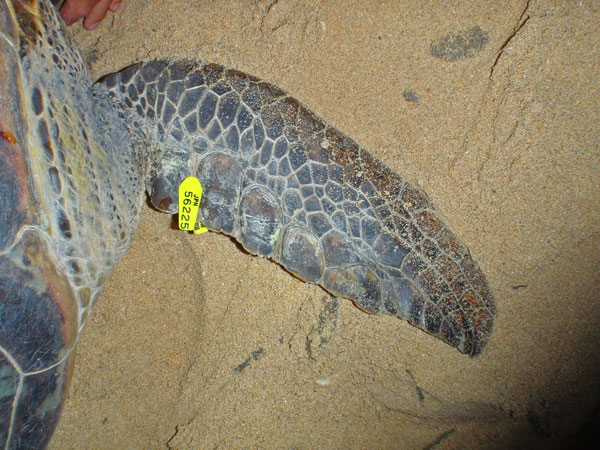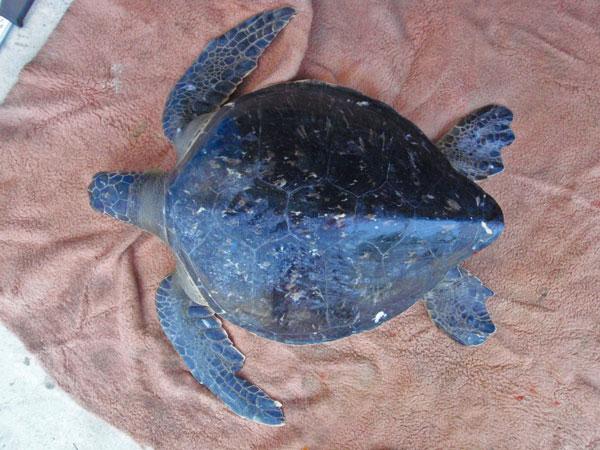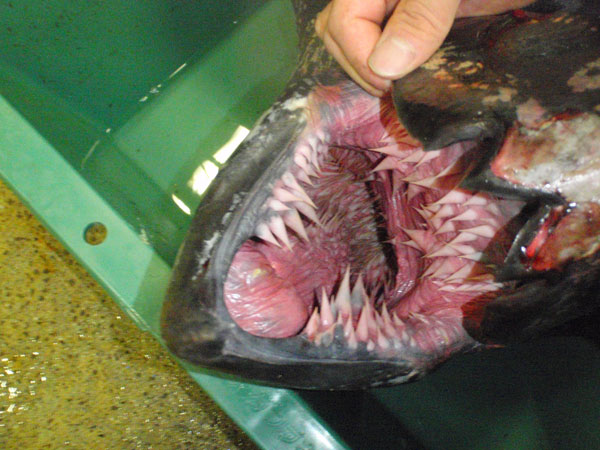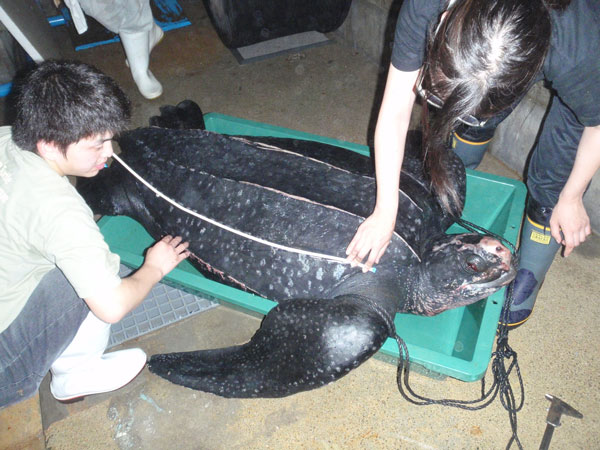
|
|
|
|
Connecting sea turtle peopleYoshimasa Matuzawa senior researcher of STAJ thinks that one of the important roles of their organization is creating the opportunity for people to exchange their information and opinion with each other and the researchers. “Local people have to count the eggs and keep eye on them in the dark because loggerhead sea turtles usually land on beaches during the night to avoid predator. Besides you do not know when and where turtles land on and lay their eggs in the vast beach. They have to walk around to look for landing turtles during the long season from spring to autumn. Naturally the data people collected is very precious, but they do not want just share their data but also talk about their experience at the beach and their loving turtles” said Matuzawa.
STAJ gives free tags to people who release sea turtles. The standard of tags is unified, so people can identify individual turtle when it is recaught. In fact the turtle released at Kushimoto Sea Park in Wakayama was caught in Baja California a year later. Another turtle released at Yoshino beach in Miyako island of Okinawa was found at the estuary of Mekong River in Vietnam and then it came back to Yoshino next year. The report will go to STAJ and people who originally released the turtle will be notified. The news often encourages people who rescued the turtle. Studying sea turtleMatuzawa studies the sex determination system of sea turtle. This means that the sand temperature surrounding turtle eggs affects gender of baby turtle. If the temperature is between 68°F and 84°F (20°C and 29°C) the turtle will be male and above that temperature it will be female. This research contributes to the conservation of sea turtles. If we collect eggs and incubate them artificially, it is possible that only female or male will hatch out without understanding this mechanism. For instance, before this study the eggs of leatherback sea turtle were incubated by human in Malaysia, but most of baby turtles was born as females and unfertilized eggs increased as a result. Recent study shows that the population of female turtles off shore Florida peninsula is increasing. That could be outcome of global warming. Okamoto, the researcher of STAJ studies the morphology and taxonomy of sea turtles. His main research now is about black sea turtles. While seven species of sea turtles are found in the world, black sea turtles are considered as a subspecies of green sea turtles. On the other hand Okamoto thinks that black sea turtles might be an individual species. So he went to Paris to compare one hundred years old spacemen with present one to prove his theory. According to Okamoto about 20 black sea turtles are found from Hokkaido to Yaeyama islands of Okinawa. “Studying the form of sea turtles is very important for conservation act, because when we found a turtle at the beach dead or alive, it is necessary for us to classify the species. If we could not tell what kind of the turtles you were looking at, you cannot tell the age of that turtle. For example, a leather back with less than 51in (130cm) carapace is probably juvenile but for a black with 27in (70cm) carapace is mature enough to breed. If we find many of adult turtles, it is possible to think that species can increase its population.” said Okamoto. 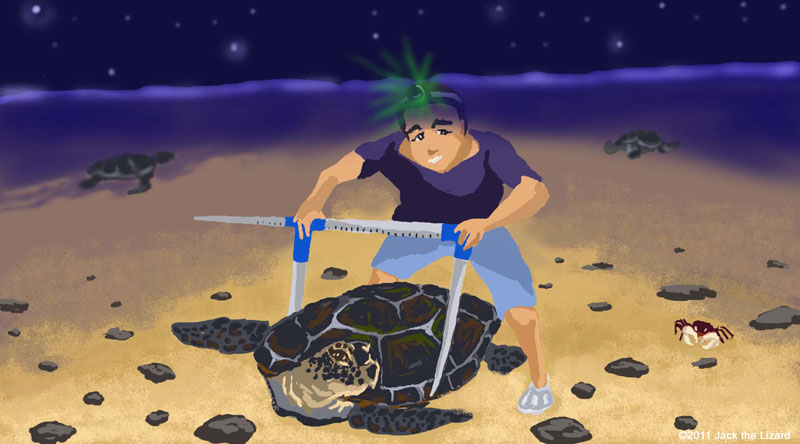
|
Sea turtles at risk
Sea turtles inhabit near the coast of Japan are loggerhead, green, hawksbill, olive ridley and leatherback. Mostly loggerhead sea turtles land on the beaches of Japan to lay their eggs. The northernmost landing site is Fukushima prefecture for the pacific side and Ishikawa is for the side of Japan Sea. Green sea turtles mostly swim around the islands of Ogasawara and Yakushima is the northernmost landing site. Hawksbill sea turtles also lay eggs at the beaches of Okinawa. The other turtles do not land on but they are found around the coast of Japan. The number of loggerhead landing and egg-laying are significantly decreased during 90’s in Japan. The main reasons are deterioration of beach condition and bycatch, while the number is recovering by conservation efforts recently. Besides Green sea turtles are doing much better because the population in Ogaswara is in fact increasing. Although Hawksbill sea turtles in Yaeyama are stabilized, their growth rate is slower than before. Okamoto explained the situation of Hawksbill. “Hawksbills mainly feed on sponges, but they are very choosy. There are more than 50 species of sponges are found in that area, but they eat only 7 of those. Low growth rate might be linked with poor condition of those sponges. Some also pointed out that the relation between corals and sponges.” |
Umigame with Us
Every day STAJ gets the report of that sea turtle bodies washed up on the beach. The number is surprising 400 to 500 in Japan. Okamoto carries out an autopsy and he usually concluded that probable cause of death is suffocation, neither eating plastic bags instead of jellyfish nor severe injury. Bycatch means that fishery boats mistakenly catch sea turtles and sea birds in their fishing nets and hooks. Bycatch sea turtles are usually trapped by fixed shore nets, gillnet and round haul net. They breathe with lung and need to come up to the surface once in a while. Since the top of fishing nets are closed, turtles cannot take a breath once they are trapped. Now STAJ is developing new fishing nets with the escaping hole for sea turtles. Fishermen and researchers also join this project to improve efficiency of new net. STAJ exhibits the experiment of new nets to educate public about sea turtles at Suma Aqualife Park Kobe.
“Bycatch is one of the top primal issues we have to solve as soon as possible. To do so we consult fishermen on developing new nets. In fact Japanese longline fishermen developed so called “Tori-pole” which is the tape attached at tale of fishing boat. Thanks to the Tori-pole for reducing sea bird bycatch almost 90%, because sea birds avoid those tapes.” Matuzawa said. Unfortunately the threat is not only bycatch but the environment of egg-laying site is also future concern. Sea turtles lay eggs away from water, because they want to protect eggs from being washed away by waves or hurricane. However turtles are blocked by the beach protecting structure such as tetrapod and breakwater. The beach itself is also disappearing, because upper river dams stop sand to flow into beach and the alternation of current by detached breakwater causes erosion of beach. “Beaches have complete ecosystem and healthy beaches have four major sources of sand to keep their condition. Rivers supply sand to beaches from land and waves do same role from sea. The forest behind beaches prevents sand blowing away and beach plants such as beach morning glory and vitex also have sand staying in beaches. Furthermore the forest shuts the light coming from homes and roads, that is good for the turtles because they will not land on if there are too many lights on the beach.” said Matuzawa. It is difficult to keep healthy beaches and protect people from natural disaster at the same time. However sea turtles were coming back and laid eggs at the beach of Toyohashi city when the break water was removed. |
Ocean without BoundaryMost of sea turtle species are on the red list of the International Union for Conservation of Nature (IUCN). Sadly loggerhead and green sea turtles are ranked as endangered species. Furthermore Hawksbill and leatherback are designated for the critically endangered species, means that they are next to face extinction.
Matuzawa is a member of the marine turtle specialist group in IUCN and he is involved in making decisions on sea turtle status of the red list. “Sea turtles swim around all over the world ocean and their life span is relatively long. Therefore some doubt that sea turtles and land animals get same status on the red list. For that reason the marine turtle specialist group may make new category for sea turtles.” said Matuzawa. Moreover sea turtle conservation in Japan is included in 10 urgent issues on world sea turtles announced by IUCN. To reduce bycatch U.S.A. and Mexico also created prohibited fishing zone and call fishermen to cooperate with. The world is waiting the response from Japan. 
Senri beach in Minabe town in Wakayama has the highest density of laying eggs by sea turtles in Honshu Island of Japan. Matsuzawa explain to local children about sea turtles, their beach and environment using the model of sea turtle. Okamoto explains that the sea turtle conservation has complex aspects. “A sea turtle plays key role in one of the most famous folktale in Japan called Urashima Tarou. If sea turtles disappear from the sea around Japan, we cannot pass it to next generation”. Some fishermen make the monument for sea turtles to console their soul while some communities traditionally eat sea turtles. I think that cultural and traditional value of sea turtles is also important.” Matuzawa thinks that it is necessary to save the whole ecosystem surrounding sea turtles. “We are able to understand the condition of a forest by studying some of large land animals such as tigers and bears. Sea turtles are same position in the ocean and as an umbrella species protecting them means conserving whole ecosystem surrounding them. Not only fishing industries can get benefit from this act but people can enjoy the leisure at beaches too.” said Matuzawa. |
